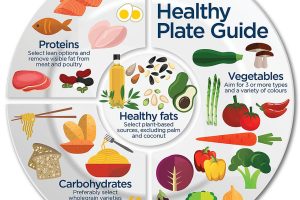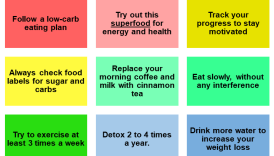Fueling Your Body Right: Mastering the Healthy Plate

Eating well is not just about following a fad diet; it’s about understanding how to nourish the body in a balanced way. Everyone has different nutritional needs, and understanding the fundamentals of nutrition can empower anyone to make better food choices.
- Fueling Your Body Right: Mastering the Healthy Plate
- The Importance of Nutrition
- Key Takeaways
- Understanding Nutrition Basics
- Macronutrients
- Micronutrients
- Building a Balanced Plate
- Portion Control
- Food Group Proportions
- Incorporating Fruits and Vegetables
- Benefits of Colorful Produce
- Creative Ways to Eat More
- Choosing Lean Proteins
- Importance of Protein
- Plant-based Protein Options
- Healthy Fats for Optimal Health
- Different Types of Fats
- Sources of Healthy Fats
- Hydration and Its Role in Wellness
- Importance of Drinking Water
- Hydrating Foods to Include
- Smart Snacking Strategies
- Nutritious Snack Choices
- Avoiding Empty Calories
- Mindful Eating for Improved Digestion
- Benefits of Mindful Eating
- Tips for Mindful Consumption
The Importance of Nutrition
Nutrition plays a vital role in overall health, energy levels, and well-being. It’s fascinating how certain foods can enhance mood, boost immune function, and even improve focus. For example, after I switched to a more balanced diet including whole grains and leafy greens, I noticed a distinct increase in my energy throughout the day.
Key Takeaways
To begin your journey toward healthier eating, consider the following essentials:
- Macronutrients: Understanding carbohydrates, proteins, and fats.
- Micronutrients: Recognizing the significance of vitamins and minerals.
- Balanced Plates: The concept of portion control and food group proportions.
By grasping these basic principles, individuals can create personalized eating plans that suit their lifestyles and preferences. Let’s explore this topic further to build a solid foundation for healthy eating habits!
Understanding Nutrition Basics
After grasping the importance of nutrition, the next step is to dive into the foundational elements: macronutrients and micronutrients. These components are the building blocks of any healthy diet and play distinct yet complementary roles in our overall health.
Macronutrients
Macronutrients are the nutrients we need in large amounts, and they provide our bodies with energy. There are three main categories:
- Carbohydrates: The primary source of energy. Think whole grains, fruits, and vegetables.
- Proteins: Essential for growth and repair. Sources include lean meats, beans, and dairy.
- Fats: Necessary for hormone production and nutrient absorption. Healthy fats can be found in avocados, nuts, and olive oil.
I remember a time when I was clocking long hours at work; incorporating more protein-rich snacks helped keep my energy stable throughout the day.
Micronutrients
On the other hand, micronutrients are needed in smaller quantities but are equally crucial for well-being. These include vitamins and minerals that support various bodily functions:
- Vitamins: Important for processes like immunity and energy production. Examples are vitamin C and B vitamins.
- Minerals: Vital for bone health and nerve function, including calcium and iron.
Understanding these basics sets the stage for building a balanced plate, ensuring that all nutritional needs are met effectively.
Building a Balanced Plate
Now that we understand the fundamental components of nutrition, it’s time to explore how to put this knowledge into practice by building a balanced plate. This aspect is essential for ensuring that meals are both satisfying and nutritious.
Portion Control
Portion control is a vital skill, especially in a world filled with oversized servings. It helps prevent overeating and can lead to better digestion. A simple technique I use is the “hand method”:
- Protein: A portion about the size of your palm.
- Carbohydrates: A fist-sized amount.
- Fats: A thumb-sized portion.
By visualizing portion sizes, it becomes easier to make healthier choices without feeling deprived.
Food Group Proportions
Next, let’s consider how to proportion different food groups on your plate:
- Vegetables: Aim for half your plate to be filled with colorful vegetables.
- Whole grains: A quarter of the plate should consist of whole grains, like brown rice or quinoa.
- Proteins: The remaining quarter can include lean proteins.
This method not only promotes a variety of nutrients but also makes meals visually appealing. Watching the colors fill my plate always excites me about eating healthy! By practicing portion control and balancing food groups, individuals can optimize their nutrition while enjoying their meals.
Incorporating Fruits and Vegetables
With a balanced plate in mind, let’s now focus on incorporating more fruits and vegetables into our daily diets. These colorful foods are not just visually appealing; they also come with a plethora of health benefits!
Benefits of Colorful Produce
Eating a variety of colorful fruits and vegetables provides essential vitamins, minerals, and antioxidants. Each color typically represents different nutrients:
- Red (like tomatoes and strawberries): Rich in lycopene, great for heart health.
- Green (such as spinach and broccoli): Packed with iron and calcium, supporting bone health.
- Orange/Yellow (like carrots and oranges): High in vitamin C, excellent for boosting the immune system.
I’ve noticed that adding a rainbow of produce to my meals not only enhances flavor but also keeps my energy levels high throughout the day.
Creative Ways to Eat More
Finding innovative ways to eat more fruits and vegetables can be fun and effective:
- Smoothies: Blend your favorite fruits with leafy greens for a nutritious drink.
- Stir-fries: Incorporate a mix of colorful vegetables for a quick and flavorful meal.
- Snacks: Keep cut veggies and hummus handy for easy, healthy snacking.
By embracing these strategies, individuals can effortlessly boost their fruit and vegetable intake, contributing to their overall wellness.
Choosing Lean Proteins
As we continue our journey towards healthier eating, it’s crucial to focus on protein—an essential nutrient that plays a significant role in our bodies. After ensuring our plates are colorful with fruits and vegetables, the next step is choosing the right protein sources.
Importance of Protein
Protein is essential for building muscles, repairing tissues, and producing hormones. It also keeps you feeling full, which is helpful in managing appetite. I noticed a big difference in my satiety after including more lean protein in my meals, like grilled chicken or fish. To ensure you’re getting enough protein, consider including:
- Lean meats: Chicken, turkey, and fish.
- Dairy: Greek yogurt and low-fat cheese.
- Eggs: A versatile and nutrient-rich option.
Plant-based Protein Options
For those looking to diversify their protein sources, plant-based options are not only healthy but also delicious. These can include:
- Legumes: Beans, lentils, and chickpeas are protein-packed and versatile.
- Nuts and seeds: Almonds, chia seeds, and hemp seeds are great additions to meals and snacks.
- Whole grains: Quinoa and farro offer protein alongside fiber.
By combining these options, individuals can enjoy a balanced diet rich in lean protein, promoting overall health and well-being.
Healthy Fats for Optimal Health
Having explored the importance of lean proteins, it’s essential to pivot our focus to fats—an often misunderstood part of nutrition. Contrary to popular belief, not all fats are created equal, and some are vital for optimal health.
Different Types of Fats
Fats can be categorized into several types, each with its own effects on health:
- Saturated Fats: Found in animal products like butter, cheese, and red meat. Moderation is key with these fats.
- Trans Fats: Often found in processed foods, these should be avoided as much as possible due to their adverse health effects.
- Unsaturated Fats: These are the healthy fats, which can be further divided into:
- Monounsaturated: Beneficial for heart health, found in olive oil and avocados.
- Polyunsaturated: Includes omega-3 and omega-6 fatty acids from sources like fish and walnuts.
Sources of Healthy Fats
Incorporating healthy fats into your diet can be simple and delicious. Consider adding:
- Avocados: Perfect for salads or as a spread.
- Nuts: A handy snack option or topping for yogurts.
- Seeds: Chia and flaxseeds are great for smoothies or oatmeal.
I’ve found that adding a drizzle of olive oil over my veggies not only enhances flavor but also provides essential nutrients. By embracing healthy fats, individuals can support their health while enjoying a varied and satisfying diet.
Hydration and Its Role in Wellness
As we continue to explore the components of a healthy diet, we shouldn’t overlook the importance of hydration. After choosing healthy fats, the next step is to ensure that we are adequately hydrated, as water plays a crucial role in overall well-being.
Importance of Drinking Water
Drinking enough water is essential for various bodily functions, including digestion, absorption, and even temperature regulation. I learned the hard way how dehydration can impact energy levels and focus; after a long day with insufficient water, I felt sluggish and unfocused. To maintain hydration, aim for:
- Eight 8-ounce glasses a day: Often referred to as the “8×8 rule,” which is easy to remember.
- Increased intake during exercise: Adjust based on activity levels and climate.
Hydrating Foods to Include
In addition to drinking water, you can increase hydration through certain foods. Incorporate these hydrating foods into your meals:
- Cucumbers: Contain about 95% water, making them a crisp snack.
- Watermelon: Refreshing and packed with vitamins.
- Leafy greens: Spinach and lettuce are not only nutritious but also hydrating.
By prioritizing hydration through both beverages and food, individuals can boost their wellness, enhance energy levels, and support overall health.
Smart Snacking Strategies
With a firm understanding of hydration’s importance, it’s now time to talk about snacking—a topic often overlooked when discussing healthy eating habits. Snacking can either support your nutritional goals or sabotage them, so choosing wisely is key.
Nutritious Snack Choices
Nutritious snacks can keep energy levels up while providing essential nutrients. Instead of reaching for processed snacks high in sugars and unhealthy fats, consider options like:
- Greek yogurt with berries: A satisfying blend of protein and fiber.
- Hummus and veggies: Provides healthy fats and a crunch.
- Nuts: A small handful offers healthy fats, protein, and fiber.
I remember when I started keeping healthy snacks readily available; my cravings for processed junk significantly decreased.
Avoiding Empty Calories
Empty calories from sugary or highly processed foods can lead to energy crashes and increased hunger. To avoid these pitfalls:
- Limit sugary drinks: Choose water or herbal teas instead.
- Read labels: Look for added sugars in packaged snacks.
- Plan ahead: Prepare healthy snacks in advance to resist the temptation of convenience foods.
By incorporating smart snacking strategies into daily routines, individuals can maintain energy levels and support their overall health while enjoying delicious flavors.
Mindful Eating for Improved Digestion
Having explored the realm of smart snacking, it’s time to shift our focus to an often-overlooked aspect of healthy eating: mindful eating. Practicing mindfulness at mealtime can significantly enhance digestion and overall enjoyment of food.
Benefits of Mindful Eating
Mindful eating involves paying full attention to the experience of eating, which can lead to a deeper appreciation for food and better digestion. The benefits include:
- Enhanced Awareness: Being in tune with hunger and fullness cues, preventing overeating.
- Improved Digestion: Eating slowly allows the body to process food more efficiently.
- Greater Satisfaction: Savoring each bite can lead to more enjoyment and less guilt.
I often find that when I focus on my meal without distractions like my phone or television, I feel more satisfied and content.
Tips for Mindful Consumption
To integrate mindful eating into daily life, try these strategies:
- Slow Down: Chew thoroughly and put your utensils down between bites.
- Limit Distractions: Create a peaceful eating environment free from screens or noise.
- Engage Your Senses: Notice the colors, textures, and aromas of your food.
By adopting these mindful eating practices, individuals can enhance their digestion and foster a healthier relationship with food.




